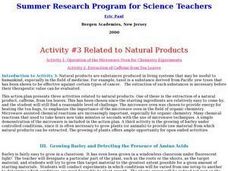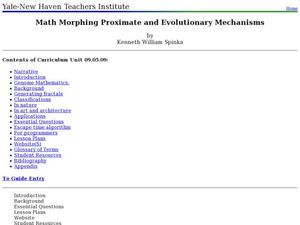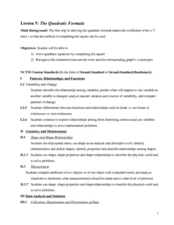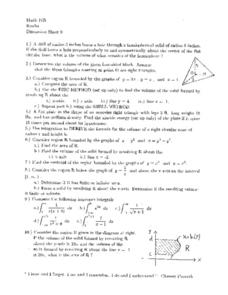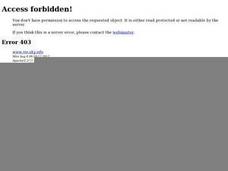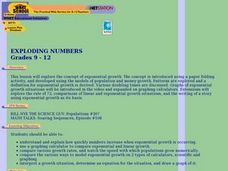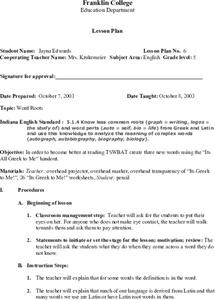Curated OER
Growing Barley and Detecting the Presence of Amino Acids
Students produce the greatest mass of plant material possible for 100 seeds of barley, and detect amino acids in barley plant material. They develop rules for the investigation, conduct the experiment, and prepare a computer spreadsheet...
Curated OER
Worksheet 22 - Spring 1996
students examine the potential of creating the involute for a circle. They use the concept to create new parametric equations. They graph the picture for each.
Curated OER
Roller Coaster Robot
Pupils calculate the area under a curve. In this calculus lesson, students use Riemann sums to find and approximate the area under a curve. They use the derivative and differential equations to solve.
Curated OER
Math Morphing Proximate and Evolutionary Mechanisms
Students identify the different types of fractals. In this geometry lesson, students use math to analyze different biological phenomena. They collect data from the experiments and construct graphs.
Curated OER
Numerical Analysis: Analyzing Root Finding Algorithms
In this root finding activity, students compare graphs and shade in regions corresponding to given convergence criteria. They compute the solution of equations of one variable. This two-page activity contains six problems.
Curated OER
Functions and Slopes
In this function instructional activity, students find the slope of a line tangent to a given graph, they derive formulas for the area and perimeter of a given right triangle, they graph functions, and compute the derivative of...
Curated OER
Calculus Practice Test: Velocity, Functions
For this calculus worksheet, learners observe graphs and identify the limits of the functions listed in the graph. They determine the definite integrals and derivatives. Students use the trapezoid rule to estimate distance. This...
Curated OER
The Quadratic Formula
Young scholars derive the quadratic formula. In this algebra instructional activity, students use the quadratic formula to solve equations and identify the roots of a quadratic equation. They graph their parabola and analyze it.
Curated OER
Discussion Sheet 5: Differentiate Functions
In this differentiate function worksheet, students differentiate functions, determine intervals, and derive the equation of a line tangent to a graph of a function. This two-page worksheet contains eleven problems.
Curated OER
Discussion Sheet 9: Volume and Area
In this volume and area worksheet, students find the volume and area of three-dimensional figures. They consider regions bounded by graphs, use integration to derive a formula, and use the disc and shell methods for volume. This...
Curated OER
Inverse Trig Functions: Chain Rule
In this trigonometric functions worksheet, students differentiate inverse trigonometric functions using the chain rule. There are 15 questions.
Curated OER
Implicit Differentiation
In this implicit differentiation worksheet, students solve problems using the chain rule and implicit differentiation. They explain the differences between the chain rule and the implicit differentiation. This two-page worksheet...
Curated OER
Curve Sketching
In this calculus instructional activity, students identify the point of increase and decrease on a graph. They analyze the curve of a graph using the derivative. There are 10 open questions about derivatives.
Curated OER
Kansas Foods A Data and Probability Investigation
Students study a number of food products and anticipate which are derived from Kansas crops. They make a list of words associated with the food stuffs and graph the results.
Curated OER
AP Calculus Practice Exam
In this calculus worksheet, 12th graders assess their knowledge of functions, integrals, trigonometric functions, derivatives, and limits. The four page worksheet contains twenty-eight multiple choice questions. Answers are...
Curated OER
Reflections of a Linear Function
Young scholars identify and reflect functions about the X-axis, Y-axis, and origin. They derive equations for reflected functions and graph the linear functions. Finally, students identify that f(x) can be reflected about each axis and...
Curated OER
Worksheet #5, Concavity,
For this calculus worksheet, students determine the intervals in which a given relation is concave up. They determine the inflection points of a given formula. Students use the second derivative test to classify the relative extrema of a...
Curated OER
Exploding Numbers
Students discuss how numbers increase when exponential growth is occurring. They view a video and compare exponential and linear growth with a graphing calculator.
Curated OER
Transformations
Tenth graders recognize, perform and derive rules for basic transformations including translation, reflection and rotation. They also consider compositions, a combination of two or more basic transformations. Students explore both...
Curated OER
Periodic Table
Young scholars relate to the idea of periodicity & give example of other periodic events and identify and use the periodic table as a useful resource. They also identify the relationship of elements to certain groups & periods...
Curated OER
Hyperbolas
Students find the center, foci, vertices, and asymptotes of hyperbolas. They graph hyperbolas and determine the equation of a hyperbola with a horizontal transverse axis. They derive general coordinates for the foci of a hyperbola with a...
Curated OER
Let's Get To the Core!
Students practice analyzing ice core samples to discover climate changes. Using the samples, they identify and graph the gas amounts. They use these numbers to determine their effect on global warming. In pairs, they complete a...
Curated OER
Word Roots
Fifth graders discover that for some words, the definition is actually in the word and that much of our language is derived from Latin and many words have Latin roots. They look at the definition part of the worksheet and go over it...
Curated OER
Chinese immigrants in British Columbia, 1870
Pupils create graphs and tables on the number of Chinese in British Columbia according to 1870 Census data. They analyze the data and complete worksheets in small groups and then discuss their conclusions as a class.
